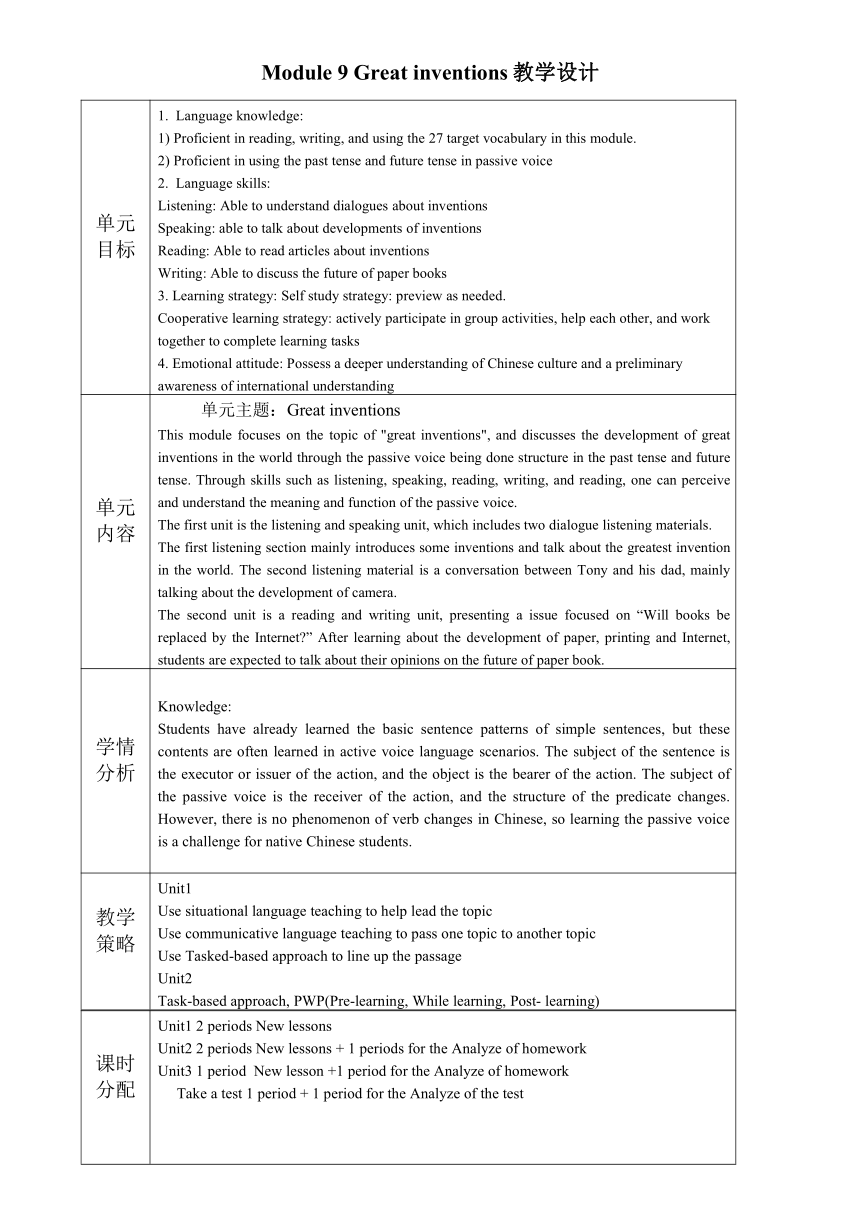
Module 9 Great inventions教学设计 单元目标 Language knowledge: Proficient in reading, writing, and using the 27 target vocabulary in this module. Proficient in using the past tense and future tense in passive voice Language skills: Listening: Able to understand dialogues about inventions Speaking: able to talk about developments of inventions Reading: Able to read articles about inventions Writing: Able to discuss the future of paper books 3. Learning strategy: Self study strategy: preview as needed. Cooperative learning strategy: actively participate in group activities, help each other, and work together to complete learning tasks 4. Emotional attitude: Possess a deeper understanding of Chinese culture and a preliminary awareness of international understanding 单元内容 单元主题:Great inventions This module focuses on the topic of "great inventions", and discusses the development of great inventions in the world through the passive voice being done structure in the past tense and future tense. Through skills such as listening, speaking, reading, writing, and reading, one can perceive and understand the meaning and function of the passive voice. The first unit is the listening and speaking unit, which includes two dialogue listening materials. The first listening section mainly introduces some inventions and talk about the greatest invention in the world. The second listening material is a conversation between Tony and his dad, mainly talking about the development of camera. The second unit is a reading and writing unit, presenting a issue focused on “Will books be replaced by the Internet ” After learning about the development of paper, printing and Internet, students are expected to talk about their opinions on the future of paper book. 学情分析 Knowledge: Students have already learned the basic sentence patterns of simple sentences, but these contents are often learned in active voice language scenarios. The subject of the sentence is the executor or issuer of the action, and the object is the bearer of the action. The subject of the passive voice is the receiver of the action, and the structure of the predicate changes. However, there is no phenomenon of verb changes in Chinese, so learning the passive voice is a challenge for native Chinese students. 教学策略 Unit1 Use situational language teaching to help lead the topic Use communicative language teaching to pass one topic to another topic Use Tasked-based approach to line up the passage Unit2 Task-based approach, PWP(Pre-learning, While learning, Post- learning) 课时分配 Unit1 2 periods New lessons Unit2 2 periods New lessons + 1 periods for the Analyze of homework Unit3 1 period New lesson +1 period for the Analyze of homework Take a test 1 period + 1 period for the Analyze of the test 课题 Unit 2 Will books be replaced by the Internet? 课型 阅读课 学情分析 本课围绕书本及因特网的优劣展开阅读教学。继续巩固一般将来时态的被动语态并区别使用其他时态的被动语态;理清作者的写作思路,提取信息 ... ...
~~ 您好,已阅读到文档的结尾了 ~~

